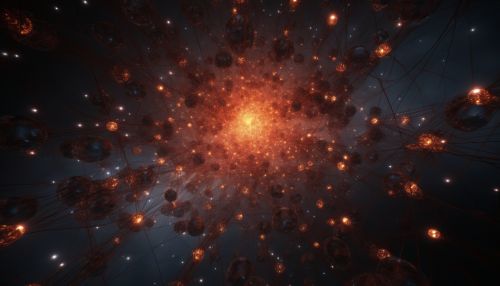Many-body Theory
Introduction
Many-body theory is a branch of quantum mechanics that deals with systems containing a large number of interacting particles. The theory is a cornerstone of modern physics and is used to describe a wide range of phenomena in various fields, including condensed matter physics, nuclear physics, and quantum chemistry. The complexity of many-body systems arises from the interactions between particles, which can lead to emergent phenomena that are not present in single-particle systems.


Basic Concepts
The primary concept in many-body theory is the wave function, a mathematical function that describes the quantum state of a system of particles. This wave function is a solution to the Schrödinger equation, a fundamental equation in quantum mechanics. The wave function provides a complete description of the system's state, including information about the particles' positions, momenta, spins, and other quantum properties.
Another key concept in many-body theory is the Hamiltonian, an operator that represents the total energy of the system. The Hamiltonian includes terms for the kinetic energy of the particles, their potential energy due to interactions with external fields, and their interaction energy with each other.
Methods in Many-Body Theory
There are several methods used in many-body theory to solve the Schrödinger equation for a system of interacting particles. These methods include perturbation theory, the variational method, and the Green's function method.
Perturbation Theory
Perturbation theory is a method used to approximate the solutions to the Schrödinger equation when the Hamiltonian of the system can be separated into a solvable part and a small perturbation. The solutions are then expanded in a series, with each term in the series representing the effect of the perturbation to a certain order.
Variational Method
The variational method is a technique used to approximate the ground state energy of a system. The method involves choosing a trial wave function and minimizing its expectation value with respect to the Hamiltonian. The resulting energy is an upper bound to the true ground state energy.
Green's Function Method
The Green's function method is a powerful tool in many-body theory. It involves calculating the Green's function of the system, which is a function that encodes the response of the system to a small perturbation. The Green's function can be used to calculate various properties of the system, such as its energy spectrum and correlation functions.
Applications of Many-Body Theory
Many-body theory has a wide range of applications in various fields of physics.
Condensed Matter Physics
In condensed matter physics, many-body theory is used to describe the behavior of electrons in solids. The theory can explain various phenomena, such as superconductivity, magnetism, and the quantum Hall effect.
Nuclear Physics
In nuclear physics, many-body theory is used to describe the behavior of nucleons (protons and neutrons) in atomic nuclei. The theory can explain the structure of nuclei and the mechanisms of nuclear reactions.
Quantum Chemistry
In quantum chemistry, many-body theory is used to describe the behavior of electrons in molecules. The theory can predict the properties of molecules, such as their energy levels, bond lengths, and reaction rates.
